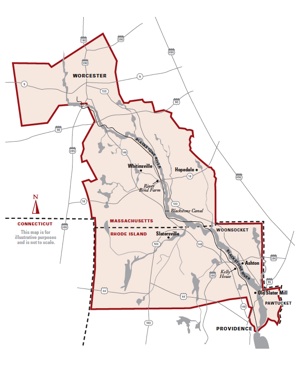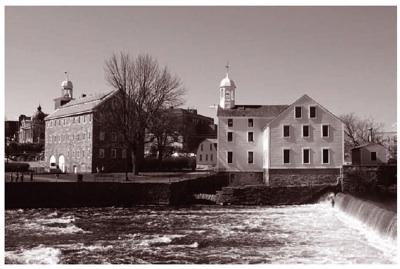The Blackstone River Valley runs for 46 miles through Massachusetts and Rhode Island, a bucolic ribbon (in places) that harbors stories of the country's transformation from an agrarian nation to an industrialized one.
It was in the Blackstone River Valley that the country's Industrial Revolution took grip of an entire region.
"The cotton mills themselves became the incubators of a new discipline of work, driven by clock-time and the pace of modernity," notes a special resource study the National Park Service conducted to determine whether the valley, currently designated as a national heritage corridor, should be given the more formal title of national historical park or historic site.
Although industrialization reshaped all aspects of American life, it did not follow a uniform process. The Blackstone Valley exemplifies one of several main paths to industrialization. This distinctive form was so closely associated with the area where it originated that it became known as the Rhode Island System of manufacture. In general, the Rhode Island System was characterized by its relatively small-scale mills, ownership by individuals or partnerships rather than corporations, use of families as the labor force, location in multiple detached villages in a rural setting, and a symbiotic relationship with agriculture. It represents the first successful application of the factory system of manufacturing in the U.S., employing machines driven by a central power source and tended by semi-skilled workers.
Back in 2006 Congress reauthorized the John H. Chafee Blackstone River Valley National Heritage Corridor Commission for five more years. The commission is scheduled to sunset this October, although the "National Heritage Corridor" label will remain intact.
Through August 26 the Park Service's Northeast Region Office is taking public comment on whether the Blackstone River Valley is deserving of national historical park status. There are a number of consequences of such a designation. For starters, management, interpretation, and preservation of the area would be taken over by the National Park Service. Minus that change in designation, and with the decommissioning of the Blackstone River Valley National Heritage Corridor Commission, there would be no official entity in place to oversee continued preservation and interpretation of the region.
Among the options the Northeast Regional staff is considering are:
* Let the commission sunset.
Just as they do now, in the absence of the federal commission, a cadre of volunteers and docents in combination with the staff of key institutions like the state parks, the Museum of Work and Culture and Old Slater Mill would continue to offer visitor programming and exhibits. Existing visitor facilities would be maintained and made available to the public by their respective owner/operators.

The Blackstone River Valley runs through parts of Massachusetts and Rhode Island. NPS graphic.
* Have Congress designate the region, or parts of it, as a national historical park, an entity managed and staffed by the Park Service.
The new unit would include specific nationally significant sites and districts located within the Valley that possess high resource integrity and effectively convey the industrial heritage themes of the Blackstone Valley. The park would engage in visitor programming and resource protection primarily for the sites and districts that would be named in the legislation establishing the park.
* Redesignate the existing Old Slater Mill National Historic Landmark as a national historic site.
The Old Slater Mill National Historic Landmark District would continue to be owned, administered, managed, and operated by the Old Slater Mill Association (OSMA). The National Park Service would have the authority to enter into cooperative agreements with OSMA to preserve and maintain the Old Slater Mill, Wilkinson Mill, Sylvanus Brown House and other characterdefining features within the National Historic Site boundary and to assist in education programs, research, and interpretation of Old Slater Mill and other related industrial heritage sites throughout the Blackstone River Valley.
* Create a Blackstone River Valley Industrial Heritage Network
This option calls for the creation of a permanent program of the National Park Service that would be dedicated to the recognition of the nationally significant story of American industrialization as it emerged in the Blackstone Valley and provide assistance for the long-term protection and interpretation of the Valley’s industrial heritage resources. The network would consist of independently-owned, thematically-related industrial heritage sites, facilities and programs that have met established criteria for program participation.
You can further research this proposal, and comment on it, at this site.




Comments
Well Ryan, if I could respond one more time. I am in the conversation concerning all the great places culturally, geographically and historically and these places give me and others the grounding to deal with the craziness that is the political process. My answer to every issue known to man, lol, is to get the principle people involved back in the hills (as Mather did) and get to a place where we are all humbled and can look correctly at all these issues.
Only as maybe a joke I bring up politics in the back country. It's a place where we all can find some peace outside the battle as our WWII veterans found on their R&R.
I believe that Park supporters need to know the whole picture and be apart of the process considering the impacts and positives. Abuse of power knows no specific party affiliations and the posts here on Kurt's site touch some important topics that are very relevant in the bigger picture and just may lead to something very good for everyone.
Take care,
Wes.
Just to bring this back around to the matter at hand, I'd like to note that Heritage Network is not one of the mangement options in the final SRS - it was proposed
in the 2010 newsletter, but generated enough confusion that it wound up
in the "considered but dismissed" pile. Which isn't entirely surprising, given the only "Heritage Network" type thing I can think of is Chesapeake Bay Gateways Network, which is a special case.
after 5 years I was rereading Kurt's story and Justin's and Rick B's thoughts, I could not resist reply to admin's point about "Heritage Newtwork" only existing in the Chesapeake Bay.
Well in fact all the national heritage corridors and national heritage areas are (generically) 'heritage networks,' and in someways Chesapeake was based on the existing heritage areas.
the real reason the "network" did not catch interest is most local people would have preferred to keep the existing federal commission and national heritage corridor, which was an effective network already. But years ago either the Congress committee staffer for maybe the NPS Washington office budget people sent a message that the problem with the existing network was that it was working too well, and needed to end. But in the years between 2004 and these comments by admin, most of those people were gone, but the NPS kept the study going in the same direction.
To the local people, if they could not continue their alliance with the National Park Service through its federal commission, they wanted it continued as a national park. As it turned out, they got a little of both, the congress did create a national historical park, but more narrowly focused than being responsible for an entire network as at Chesapeake. Instead the Congress continued the Network part as a non-federal, non-profit commission, to work together in a way similar to what we already have at Cuyahoga, or at Salem NHP with the Essex heritage area, or at Shenandoah Valley heritage area with Belle Grove national historical park and to some extent Shenandoah National Park. Several recommendations leading toward the Centennial (like the Second Century report and comments by former Dep Director Galvin) felt that the most successful model was when in highly privatized landscapes, the park has a national heritage corridor partner to cover the waterfront (or watershed, you choose)
We will see at Blackstone how this all is translated through its General Management Plan, and if congress continues to fund national heritage areas in the new Trump administration.